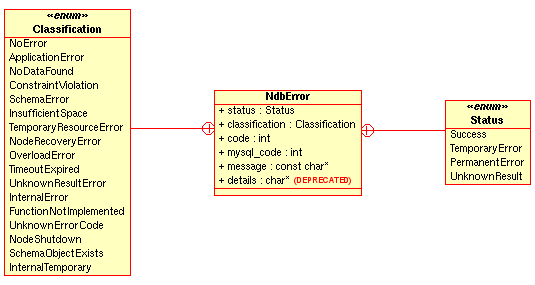- 2.3 NDB API Classes, Interfaces, and Structures
- 2.3.1 The Column Class
- 2.3.2 The Datafile Class
- 2.3.3 The Dictionary Class
- 2.3.4 The Event Class
- 2.3.5 The Index Class
- 2.3.6 The LogfileGroup Class
- 2.3.7 The List Class
- 2.3.8 The Ndb Class
- 2.3.9 The NdbBlob Class
- 2.3.10 The NdbDictionary Class
- 2.3.11 The NdbEventOperation Class
- 2.3.12 The NdbIndexOperation Class
- 2.3.13 The NdbIndexScanOperation Class
- 2.3.14 The NdbInterpretedCode Class
- 2.3.15 The NdbOperation Class
- 2.3.16 The NdbRecAttr Class
- 2.3.17 The NdbScanFilter Class
- 2.3.18 The NdbScanOperation Class
- 2.3.19 The NdbTransaction Class
- 2.3.20 The Object Class
- 2.3.21 The Table Class
- 2.3.22 The Tablespace Class
- 2.3.23 The Undofile Class
- 2.3.24 The Ndb_cluster_connection Class
- 2.3.25 The NdbRecord Interface
- 2.3.26 The AutoGrowSpecification Structure
- 2.3.27 The Element Structure
- 2.3.28 The GetValueSpec Structure
- 2.3.29 The IndexBound Structure
- 2.3.30 The Key_part_ptr Structure
- 2.3.31 The NdbError Structure
- 2.3.32 The OperationOptions Structure
- 2.3.33 The PartitionSpec Structure
- 2.3.34 The RecordSpecification Structure
- 2.3.35 The ScanOptions Structure
- 2.3.36 The SetValueSpec Structure
Abstract
This section discusses the NdbError data
structure, which contains status and other information about
errors, including error codes, classifications, and messages.
Description.
An NdbError consists of six parts, of which one
is deprecated as of MySQL Cluster NDB 6.2.19, MySQL Cluster NDB
6.3.29, and MySQL Cluster NDB 7.0.10:
-
Error status: This describes the impact of an error on the application, and reflects what the application should do when the error is encountered.
The error status is described by a value of the
Statustype. See Section 2.3.31.1.1, “TheNdbError::StatusType”, for possibleStatusvalues and how they should be interpreted. -
Error classification: This represents a logical error type or grouping.
The error classification is described by a value of the
Classificationtype. See Section 2.3.31.1.2, “TheNdbError::ClassificationType”, for possible classifications and their interpretation. Additional information is provided in Section 5.2.3, “NDB Error Classifications”. -
Error code: This is an NDB API internal error code which uniquely identifies the error.
Important
It is not recommended to write application programs which are dependent on specific error codes. Instead, applications should check error status and classification. More information about errors can also be obtained by checking error messages and (when available) error detail messages. However — like error codes — these error messages and error detail messages are subject to change.
A listing of current error codes, broken down by classification, is provided in Section 5.2.2, “NDB Error Codes and Messages”. This listing will be updated periodically, or you can check the file
storage/ndb/src/ndbapi/ndberror.cin the MySQL 5.1 sources. MySQL Error code: This is the corresponding MySQL Server error code. MySQL error codes are not discussed in this document; please see Server Error Codes and Messages, in the MySQL Manual, for information about these.
Error message: This is a generic, context-independent description of the error.
-
Error details: This can often provide additional information (not found in the error message) about an error, specific to the circumstances under which the error is encountered. However, it is not available in all cases.
Where not specified, the error detail message is
NULL.Note
This property is deprecated as of MySQL Cluster NDB 6.2.19, MySQL Cluster NDB 6.3.29, and MySQL Cluster NDB 7.0.10. Beginning with these MySQL Cluster releases, for obtaining error details, you should use the
Ndb::getNdbErrorDetail()method instead. See Section 2.3.8.1.16, “Ndb::getNdbErrorDetail()”, for more information.
Important
Specific NDB API error codes, messages, and detail messages are subject to change without notice.
Definition. The NdbError structure contains the following members, whose types are as shown here:
-
Status status
The error status.
-
Classification classification
The error type (classification).
-
int code
The NDB API error code.
-
int mysql_code
The MySQL error code.
-
const char* message
The error message.
-
char* details
The error detail message.
Note
detailsis deprecated as of MySQL Cluster NDB 6.2.19, MySQL Cluster NDB 6.3.29, and MySQL Cluster NDB 7.0.10. Beginning with these MySQL Cluster releases, for obtaining error details, you should use theNdb::getNdbErrorDetail()method instead. See Section 2.3.8.1.16, “Ndb::getNdbErrorDetail()”, for more information. (Bug#48851)
See the Description for more information about these members and their types.
Types.
NdbError defines two datatypes:
Status: The error status. See Section 2.3.31.1.1, “TheNdbError::StatusType”.Classification: The type of error or the logical grouping to which it belongs. See Section 2.3.31.1.2, “TheNdbError::ClassificationType”.
Structure Diagram.
This diagram shows all the available members and types of the
NdbError structure:

